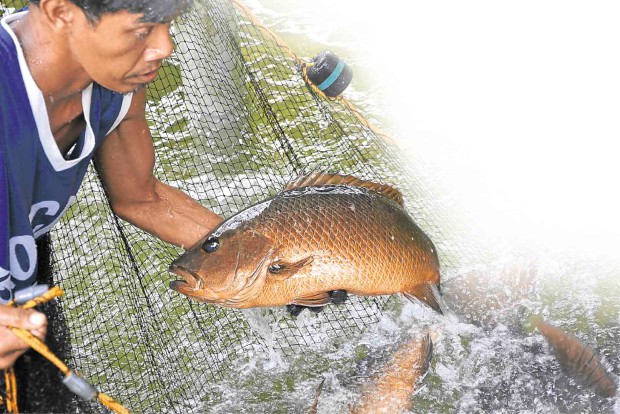
A WORKER at the National Integrated Fisheries Technology Development Center in Dagupan City shows one of the red snapper breeders, which aquaculture experts have successfully made to spawn in captivity. RAY ZAMBRANO/INQUIRER NORTHERN LUZON
DAGUPAN CITY—Aquaculture experts here announced on Friday the successful breeding in captivity of the high-value fish maya-maya (red snapper).
“This is a breakthrough for the Bureau of Fisheries and Aquatic Resources (BFAR) and we are happy that for the first time, we were able to make our breeders spawn,” said Westly Rosario, chief of BFAR’s National Integrated Fisheries Technology Development Center (NIFTDC) here.
Rosario said maya-maya were caught only in the wild, making them difficult to find in fish markets.
“[The maya-maya] is expensive, costing about P300 a kilogram,” he said.
“What we want is a diversification of species [in the food production trade] because I think we are the only Asian country which is familiar with only two species for aquaculture—Tilapia and bangus (milkfish),” he said.
“If we have other species [being cultured for the market], we have not been able to elevate them to the industrial level,” said Rosario.
“We have not been able to export because we always end up with a more expensive produce due to high production costs compared to other countries,” he said.
Because of the breakthrough, hatcheries would soon be producing maya-maya fry to ensure regular production, Rosario said.
He said the maya-maya breeders at the NIFTDC came from the Lingayen Gulf and were caught near the mouth of a river.
“We grew them for more than four years, moving them from one pond to another. Their sexual maturity is supposed to be only two years. But [our maya-maya] spawned only on June 18, during the new moon,” he said.
He said that his office would be producing the fry in semicommercial quantity and sell these to aquaculture farmers. “This can also be replicated in other places. And we can teach them,” he said. Gabriel Cardinoza, Inquirer Northern Luzon